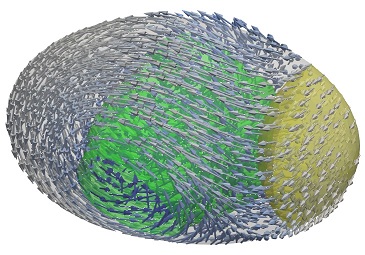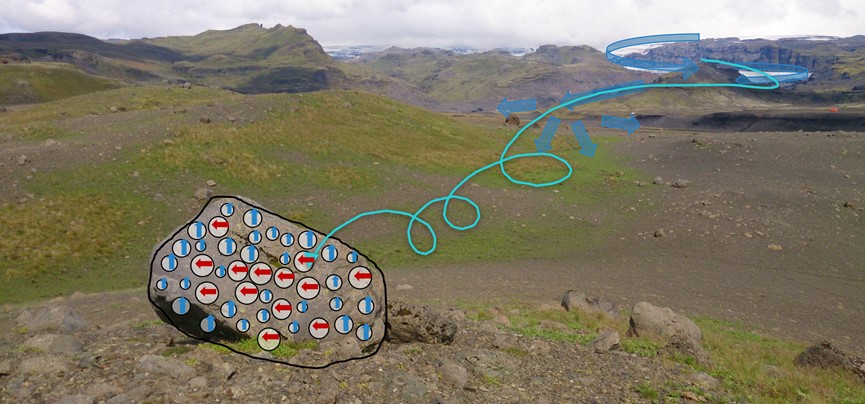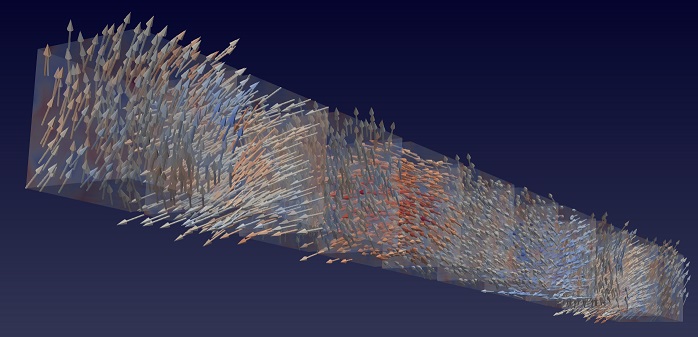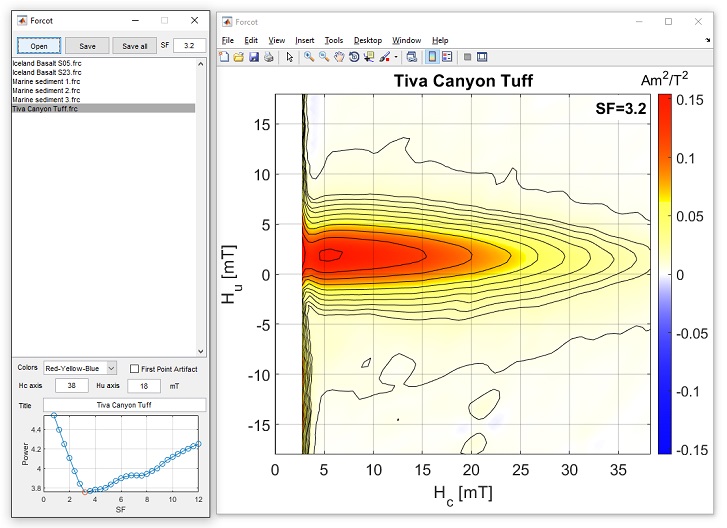地球与空间科学学院 • 助理教授
办公电话:15501171217
办公地址:理科二号楼2826
电子邮件:thomasberndt@pku.edu.cn
地球与空间科学学院 • 助理教授
办公电话:15501171217
办公地址:理科二号楼2826
电子邮件:thomasberndt@pku.edu.cn
助理教授
北京大学理论与应用地球物理研究所 (2019 至今)
博雅博士后
北京大学地球与空间科学学院 (2017—2019)
地球物理学博士
伦敦帝国理工学院 (2016)
地球物理学硕士
马德里康普卢滕斯大学 (2013)
物理学学士
南安普顿大学 (2010)
*** 招收研究生和本科生 ***
*** 招收博士后研究人员 ***
蕴藏在岩石中的磁性矿物具有独特的能力,它不仅可以记录远古时期的磁场并可以将其保存至今。为我们了解地球乃至太阳系的形成和演变提供了痕迹。岩石磁学的应用范围非常广泛:从数十亿年来对地核发电机的研究,追踪过去的岩石、巨石和大陆运动的轨迹,研究行星的形成,并且通过陨石研究太阳系的演化。
我的研究是了解岩石里的磁性矿物如何记录和保存地球和其他行星的磁场。我的研究方向主要是:(1)在地球和太阳系演化研究过程中,了解微米级和纳米级样本是如何记录磁场。(2)通过磁性在岩石中痕迹,了解自然灾害,比如:洪水和山体滑坡。(3)通过沉积物中的磁性矿物研究过去的气候变化。在研究中,使用物理学和计算机科学,包括理论研究,统计物理学,数值建模,有限元模型,蒙特卡洛模拟,以及实验工作。
Thomas Berndt现任是北京大学地空学院的助理教授,曾获得博雅奖学金并完成博雅博士后研究。之前,毕业于伦敦帝国理工学院获博士学位。曾经在由Adrian Muxworthy教授主导的自然磁性研究小组中进行了洪水的粘性剩磁化测年方法的研究,因此同时拥有西班牙马德里康普卢滕斯(Complutense)大学地球物理学硕士学位和南安普顿(Southampton)大学物理学学士学位。
近年来,微米级和纳米级古地磁研究方法被认为是具有前沿性的。它可以通过对陨石的微米古地磁成像技术,从早期太阳系演化中获得有效数据。通过陨石中的磁性矿物可以深入了解地球以外的天体——包括原行星盘、太阳、月亮、其他星球和小行星——是否存在磁电波源(发电机),从而推断出这些天体是何时且如何演化形成的。
地外物质,然而与地球上发现的任何一种物质都不同,目前对于这些复杂的物质中的磁性矿物的记录形态还没有形成共识。通过理论研究和计算工具可以了解到地外物质中的磁性矿物是如何记录和保存剩磁的,从而探索太阳系的演化过程。

从地球磁场我们可以探索地球的形成过程、地核的演变过程、地球的固化过程,以及地球上生命和其他的行星上(可能存在的)生命的进化都取决于磁场,因为磁场保护微生物免受潜在致命宇宙射线侵害,可以防止大气被太阳风吹走——数十亿年前可能曾发生在火星。
到目前为止,我们对这些方面的信息还知之甚少——仅有的获知就是来自最前沿的古地磁:地球形成的最初十亿年,即生命首次出现的时间只能通过“单硅酸盐晶体”标本测定,这也是目前研究领域最具争议的问题。我的早期研究曾经测定评估了 “单硅酸盐晶体”中最理想的磁性矿物所保存的磁场的可靠性。然而这些晶体中的磁性结构通常非常复杂,我目前的主要研究工作就是在理论上从“单硅酸盐晶体”中“非理想化”的磁性矿物里获得最早的地磁场信息。

现在,我们生活在自然灾害的高风险下。不但人类对“百年一遇”的自然灾害没有充分的认识,社会的应对能力也不足以抵御超高风险的自然灾害,我们对这些灾害的危害和影响的认识都很不足。评估未来发生海啸、洪水、滑坡以及地震等灾害的可能性,关键在于了解和测定历史上发生过的超级灾害的危害。虽然现有一系列测定年代的方法已经发展成型并得以应用,如:放射性定年法、地标裸露测年法、光谱测年技术等。但这些方法都有各自的局限性(如:对灾害可测年限的范围,遗留物质的成分,或者外部环境因素等),没有一个单一方法可以用于测定所有自然灾害遗留物的年代,甚至有一些遗留物无法用任何现有的方法进行年代测定。
我研究并采用了一种新的具有前沿性的自然灾害测年法,使用岩石中包含的磁性矿物——该方法基于自然灾害发生过程中岩石位移后所产生的磁记录:通常,岩石中的磁性粒子与地球磁场方向保持一致——北向。自然灾害造成了岩石滚动位移后,岩石中的剩磁方向发生了改变,不再是北向。随着时间的流失,岩石中的一些剩磁的方向会在缓慢的粘性剩磁过程中再次转向北方。确定粘性剩磁的进度可以计算出灾害发生的年限。
在我攻读博士学位期间,我用这种方法进行了研究和测定并得出了可喜的结果,它表明粘性剩磁测年法是一个可行的数量级的测定年限的方法。目前的研究是关于提高这个方法的准确性,它的磁性物质和灾害遗留的要求,而且进行更多的个案研究分析它的性能。我目前的研究是提高这种方法的准确性——特别是对岩石中复杂的磁性矿物,岩层类型和遗留物,以及在更广泛的区域应用这种测年方法。

沉积物中含有很丰富的生物磁性,这些生物不仅依赖于古环境和古气候,而且它们所产生的磁性矿物也记录了地球磁场和地磁发电机。由于沉积物中的磁性很容易被测量,因此它成为研究古环境和古气候的代用指标。使用沉积物磁性数值作为古环境古气候的指标的关键在于通过实验鉴定生物的磁性,其中最重要的就是趋磁细菌产生的磁小体。
我的研究是通过数值微磁模型来测定磁小体的不同形态和矿物中的磁性特征。到目前为止,这些数据包括各种磁小体的建模演示和磁小体磁性强弱以及与其相关的显微成像。目前的研究重点是沉积物的物理压缩对磁小体和其他磁性矿物形态的影响,比如:磁小体链塌陷。了解磁小体链塌陷所产生的影响,有助于提高磁小体数值作为研究古环境古气候的指标应用,也有助于更好地研究沉积物中记录的剩磁信号。
后者对于磁地层学研究的年代测定、重建相对应沉积物磁性的强度、更深入了解地球电动力学以及区域沉积、沉积剩磁和其他再磁化现象是必不可少的。后者对于磁地层学测定年限、重建相对应古地磁场的强度、更深入了解地球发电机以及区分沉积化剩磁和重磁化剩磁是必不可少的。

在自然界中,沉积岩和火成岩中通常都包含有多种不同磁性的矿物。在沉积岩中,磁性矿物的混合物是十分有趣的,因为每一种矿物都可以追踪到不同的环境和地理来源。而在火成岩中,它们可以在了解磁性剩磁成分的起源、结构和地球动力学方面发挥巨大的作用。
通过数值正向建模、前沿性的实验方法和理论研究,我开发了检测、区分和分离磁性矿物发出的混合信号。

1. Berndt, T.A., Chang, L., Paterson, G. A.,& Cao, C. 2021."Experimental Test of the Cooling Rate Effect on Blocking Temperatures in Stepwise Thermal Demagnetisation." Geophysical Journal International 224 (2): 1116–1126. https://doi.org/10.1093/gji/ggaa514
2. Berndt, T. A., Chang, L. & Pei, Z.*(2020). Mind the gap: Towards a biogenic magnetite palaeoenvironmental proxy through an extensive finite-element micromagnetic simulation. Earth and Planetary Science Letters. https://doi.org/10.1016/j.epsl.2019.116010
3. Berndt, T. A., & Chang, L. (2019). Waiting for Forcot: Accelerating FORC Processing 100x using a Fast‐Fourier‐Transform Algorithm. Geochemistry, Geophysics, Geosystems. https://doi.org/10.1029/2019GC008380
4. Chang, L., Harrison, R. J., & Berndt, T. A. (2019). Micromagnetic simulation of magnetofossils with realistic size and shape distributions: Linking magnetic proxies with nanoscale observations and implications for magnetofossil identification. Earth and Planetary Science Letters. https://doi.org/10.1016/j.epsl.2019.115790
5. Chang, L., Harrison, R. J., Zeng, F., Berndt, T. A., Roberts, A. P., Heslop, D., & Zhao, X. (2018). Coupled microbial bloom and oxygenation decline recorded by magnetofossils during the Palaeocene-Eocene Thermal Maximum. Nature Communications, 9(4007), 1–9. https://doi.org/10.1038/s41467-018-06472-y
6. Berndt, T. A., Chang, L., Wang, S., & Badejo, S. (2018). Time-Asymmetric FORC Diagrams: A New Protocol for Visualizing Thermal Fluctuations and Distinguishing Magnetic Mineral Mixtures. Geochemistry, Geophysics, Geosystems, 19, 1–28. https://doi.org/10.1029/2018GC007669
7. Berndt, T. A., & Chang, L. (2018). Theory of stable multi-domain thermoviscous remanence based on repeated domain-wall jumps. Journal of Geophysical Research: Solid Earth, 123, 1–23. https://doi.org/10.1029/2018JB016816
8. Berndt, T. A., Paterson, G. A., Cao, C., & Muxworthy, A. R. (2017). Experimental test of the heating and cooling rate effect on blocking temperatures. Geophysical Journal International, 210(1), 255–269. https://doi.org/10.1093/gji/ggx153
9. Berndt, T. A., Ramalho, R. S., Valdez-Grijalva, M. A., & Muxworthy, A. R. (2017). Paleomagnetic field reconstruction from mixtures of titanomagnetites. Earth and Planetary Science Letters, 465, 70–81. https://doi.org/10.1016/j.epsl.2017.02.033
10. Berndt, T. A., & Muxworthy, A. R. (2017). Dating Icelandic glacial floods using a new viscous remanent magnetization protocol. Geology, 45(4), 339–342. https://doi.org/10.1130/G38600.1
11. Berndt, T. A., Muxworthy, A. R., & Fabian, K. (2016). Does size matter? Statistical limits of paleomagnetic field reconstruction from small rock specimens. Journal of Geophysical Research: Solid Earth, 121(1), 1–12. https://doi.org/10.1002/2015JB012441
12. Berndt, T. A., Muxworthy, A. R., & Paterson, G. A. (2015). Determining the magnetic attempt time τ0, its temperature dependence, and the grain size distribution from magnetic viscosity measurements. Journal of Geophysical Research: Solid Earth, 120. https://doi.org/10.1002/2015JB012283
13. Berndt, T. A., Ruiz-Martínez, V. C., & Chalouan, A. (2014). New constraints on the evolution of the Gibraltar Arc from palaeomagnetic data of the Ceuta and Beni Bousera peridotites (Rif, northern Africa). Journal of Geodynamics, 84, 19–39. https://doi.org/10.1016/j.jog.2014.09.014
*Students I (co)supervised.
Dr Thomas A. Berndt
北京大学理论与应用地球物理研究所——助理教授 2019——
北京大学地球与空间科学学院——博雅博士后 2017—2019
伦敦帝国理工学院——地球物理学博士 2016
马德里康普卢滕斯大学——地球物理学硕士 2013
南安普顿大学——物理学学士 2010
布鲁塞尔自由大学-ULB——留学 2011
爱丁堡大学——留学 2009
不来梅雅各布大学——留学 2008
伦敦d-fine有限公司——风险管理顾问 2016—2017
不来梅Genese.de有限公司——程序员(兼职) 2007—2013
慕尼黑,德州仪器质量与可靠性检测(SEM实验室)——实习生 2008
不来梅莱茵金属公司——程序员(兼职) 2005—2006
不来梅Reha-Haus公司 ——自由程序员 2003—2006
美国明尼苏达岩石磁学研究所——访问学者 3.3万 2020
葡萄牙科学与技术基金会奖学金 140万 2019
国家自然科学基金委员会,生物磁铁矿研究(合作)项目(编号:41974074) 85万 2019
中国博士后科学基金第64批面上基金一等资助,
磁性海啸测年(编号: 2018M640019) 8万 2019
美国明尼苏达岩石磁学研究所——访问学者 3.3万 2017
北京大学博雅博士后奖学金 37万 2017
英国研究理事会向中国科学院地质与地球物理研究所
项目提供行程及研究资助 2.4万 2015
美国明尼苏达岩石磁学研究所——访问学者 3.3万 2015
帝国理工学院IUGG(布拉格)会议资助 3.3千 2015
美国明尼苏达岩石磁学研究所——访问学者 3.3万 2014
帝国理工学院暑期研究项目资助 2.4千 2014
帝国理工学院地球科学学院珍妮特•沃森博士奖学金 40万 2013
(金额:人民币)
北京大学
· 担任国际研究生关于铁陨石微磁模型的教学科研 2020——
· 指导科研助理(准研究生)进行硅酸盐中微磁模型的工作 2020——
· 共同承担本科生和研究生磁小体微磁模型的教学科研 2018——
· 共同承担研究生硅酸盐中微磁模型的教学科研 2017——
课程讲座(北京大学)
· 大数据方法在地球科学中的应用(研究生) 2020——
· 面向地球科学的机器学习入门(本科生) 2020——
· 岩石磁学(研究生,合作授课,4场/年) 2017——
· 地球动力学 (本科生,合作授课,1场) 2017
德国暑期课程讲师(Deutsche SchülerAkademie). 德国暑期课程是德国为最优秀的高中生开设的一项为期两周的夏令营活动,介绍最先进的学术发展和研究课题,并提供多样 化的校外课程活动。
· 区块链、比特币和数字化经济(50小时) 2019
· 艺术作品编程(50 小时) 2015
· 汉语简介(10小时,) 2015 & 2019
· 视频制作简介(10小时) 2019
地球物理夏令营——伦敦帝国理工 2014——
带领硕士生开展为期两周的用GPS进行地球物理勘探项目
助教——伦敦帝国理工 2013—2015
· 地震波勘探(硕士生)
· 计算方法2 (C++中的偏微分方程)
· 地球物理建模方法(Python)
· 火与冰(冰川建模)
· 初级编程课(面向地球物理学家)(Python)
· 高级编程课(面向地球物理学家)(C++)
其他活动
· 英国空间设计竞赛志愿者 2014
· 英国玛丽皇后文法学校进行地球科学的讲座 2014
语言技能——英语(流利) 德语(母语)西班牙语(流利)汉语(高级)法语(基础)
编程技能Matlab, Python, C++, C#, VB, SQL, LaTeX, Java, TypeScript
软件使用Word, Excel, PowerPoint, SVN, Git, Adobe Premiere, Illustrator, InDesign
仪器设备MPMS,普林斯顿VSM,JR5,VFTB,三轴高温VSM,Kappabridge,2G SQUID,扫描电子显
微镜,能量色散X射线光谱,聚焦离子束,原子力显微镜,扫描电容显微镜,XRF
审稿人Geochemistry, Geophysics, Geosystems; Journal of Geophysical Research: Solid Earth; Earth
and Planetary Science Letters; Geophysical Journal nternational
1. Pei, Z.*, Berndt, T.A., Chang, L. & Williams, W., (in prep). Magnetic Properties and Paleomagnetic Recording of Bent Magnetosome Chains: a Finite-element Micromagnetic Approach.
2. Bai, F.*, Chang, L. & Berndt, T.A., (in prep). Micromagnetic calculations of effects of magnetostatic interactions on isothermal remanent magnetization (IRM) curves: fine-grained magnetite with variable morphologies. To be submitted to Journal of Geophysical Research.
3. Berndt, T.A., Chang, L., Paterson, G. A. & Cao, C. (2021). Experimental test of the cooling rate effect on blocking temperatures in stepwise thermal demagnetisation. Geophysical Journal International 224 (2): 1116–1126. https://doi.org/10.1093/gji/ggaa514
4. Berndt, T. A., Chang, L. & Pei, Z. (2020). Mind the gap: Towards a biogenic magnetite palaeoenvironmental proxy through an extensive finite-element micromagnetic simulation. Earth and Planetary Science Letters 532 (116010): 33–43. https://doi.org/10.1016/j.epsl.2019.116010
5. Berndt, T. A., & Chang, L. (2019). Waiting for Forcot: Accelerating FORC Processing 100x using a Fast‐Fourier‐Transform Algorithm. Geochemistry, Geophysics, Geosystems 20 (12): 1–11. https://doi.org/10.1029/2019GC008380
6. Chang, L., Harrison, R. J., & Berndt, T. A. (2019). Micromagnetic simulation of magnetofossils with realistic size and shape distributions: Linking magnetic proxies with nanoscale observations and implications for magnetofossil identification. Earth and Planetary Science Letters 527 (115790). https://doi.org/10.1016/j.epsl.2019.115790
7. Chang, L., Harrison, R. J., Zeng, F., Berndt, T. A., Roberts, A. P., Heslop, D., & Zhao, X. (2018). Coupled microbial bloom and oxygenation decline recorded by magnetofossils during the Palaeocene-Eocene Thermal Maximum. Nature Communications, 9(4007), 1–9. https://doi.org/10.1038/s41467-018-06472-y
8. Berndt, T. A., Chang, L., Wang, S., & Badejo, S. (2018). Time-Asymmetric FORC Diagrams: A New Protocol for Visualizing Thermal Fluctuations and Distinguishing Magnetic Mineral Mixtures. Geochemistry, Geophysics, Geosystems, 19, 1–28. https://doi.org/10.1029/2018GC007669
9. Berndt, T. A., & Chang, L. (2018). Theory of stable multi-domain thermoviscous remanence based on repeated domain-wall jumps. Journal of Geophysical Research: Solid Earth, 123, 1–23. https://doi.org/10.1029/2018JB016816
10. Berndt, T. A., Paterson, G. A., Cao, C., & Muxworthy, A. R. (2017). Experimental test of the heating and cooling rate effect on blocking temperatures. Geophysical Journal International, 210(1), 255–269. https://doi.org/10.1093/gji/ggx153
11. Berndt, T. A., Ramalho, R. S., Valdez-Grijalva, M. A., & Muxworthy, A. R. (2017). Paleomagnetic field reconstruction from mixtures of titanomagnetites. Earth and Planetary Science Letters, 465, 70–81. https://doi.org/10.1016/j.epsl.2017.02.033
12. Berndt, T. A., & Muxworthy, A. R. (2017). Dating Icelandic glacial floods using a new viscous remanent magnetization protocol. Geology, 45(4), 339–342. https://doi.org/10.1130/G38600.1
13. Berndt, T. A., Muxworthy, A. R., & Fabian, K. (2016). Does size matter? Statistical limits of paleomagnetic field reconstruction from small rock specimens. Journal of Geophysical Research: Solid Earth, 121(1), 1–12. https://doi.org/10.1002/2015JB012441
14. Berndt, T. A., Muxworthy, A. R., & Paterson, G. A. (2015). Determining the magnetic attempt time τ0, its temperature dependence, and the grain size distribution from magnetic viscosity measurements. Journal of Geophysical Research: Solid Earth, 120. https://doi.org/10.1002/2015JB012283
15. Berndt, T. A., Ruiz-Martínez, V. C., & Chalouan, A. (2014). New constraints on the evolution of the Gibraltar Arc from palaeomagnetic data of the Ceuta and Beni Bousera peridotites (Rif, northern Africa). Journal of Geodynamics, 84, 19–39. https://doi.org/10.1016/j.jog.2014.09.014
*Students I (co)supervised.
1. 受邀演讲: 美国地球物理联合会秋季会议,美国旧金山,12/2019,Thermal fluctuations in FORC diagrams: the missing link between FORC diagrams and natural remanence acquisition.
2. 16th 城堡会议,波兰契辛尼,06/2018, Thermal fluctuations in FORC diagrams: the missing link between FORC diagrams and natural remanence acquisition.
3. 16th 城堡会议,波兰契辛尼,06/2018,Paleomagnetic field reconstruction from mixtures of titanomagnetites.
4. Magnetic Interactions会议,英国牛津, 01/2018,Time-asymmetric FORC diagrams: distinguishing magnetic phases based on their viscosity.
5. Magnetic Interactions 会议,爱丁堡,01/2017,Paleomagnetic field reconstruction from mixtures of titanomagnetites.
6. 北京地球与行星内部国际研讨会,北京, 06/2016,Viscous Remanent Magnetization Dating of Floods.
7. 中国矿业大学,徐州,05/2016,Magnetic dating of floods.
8. 欧洲地球物理联合会年会,2016,奥地利维也纳,04/2016,Magnetic dating of storm floods, jökulhlaups and tsunamis.
9. 国际大地测量与地球物理联合会年会,2015,捷克布拉格,06/2015, Viscous remanent magnetization dating of floods.
10. 美国地球物理联合会秋季会议,制作海报, 1/2018,美国华盛顿
11. 国际大地测量与地球物理联合会年会,制作海报,06/2015,捷克布拉格
12. Magnetic Interactions 会议,制作海报,01/2015,英国利兹

Thomas A. Berndt (助理教授)

Jose Devienne (博士生)

韩晨 (博士生)
*** 招收研究生和本科生 ***
*** 招收博士后研究人员 ***
Forcot is a new First-Order Reversal-Curve (FORC) processing software that uses a Fast-Fourier-Transform algorithm to accelerate smoothing significantly. Its aim is to provide as easy and frictionless a user-experience as possible to create print-quality FORC diagrams with minimum effort.
When using the software to produce figures, or when using any of the code, theory, figures, data, please cite the corresponding paper Berndt, T. A. & Chang, L. (2019). Waiting for Forcot: Accelerating FORC Processing 100x using a Fast-Fourier-Transform Algorithm. Geochemistry, Geophysics, Geosystems.
Download latest version of Forcot
For the Mac version, you may have to use the command sudo xattr -d com.apple.quarantine Forcot_MacInstaller_v1.x.x.app (replace x by version number) to allow installing the app. Alternatively, you can download the Matlab version (this requires the curve fitting toolbox, the image toolbox, and the statistics toolbox).
